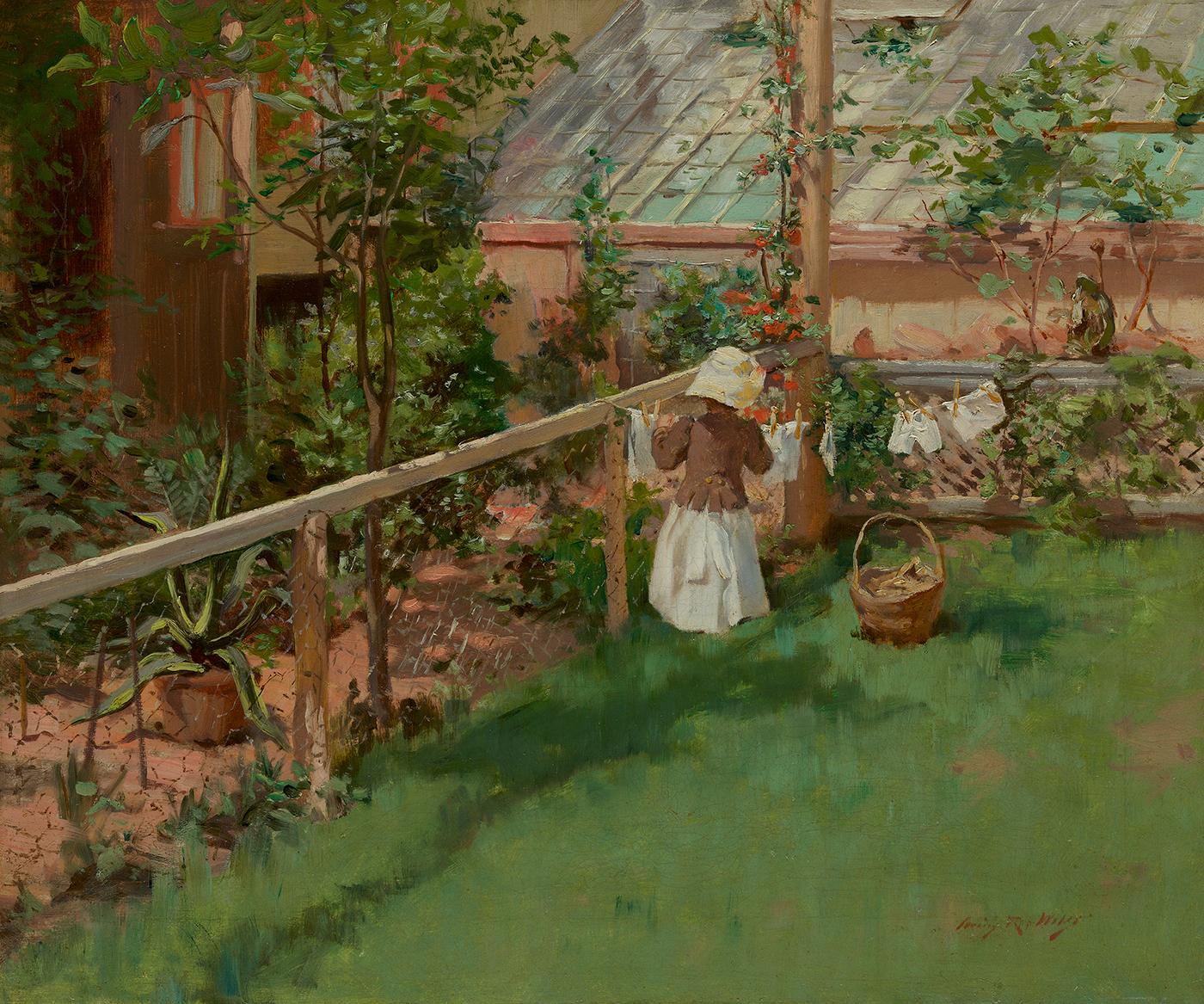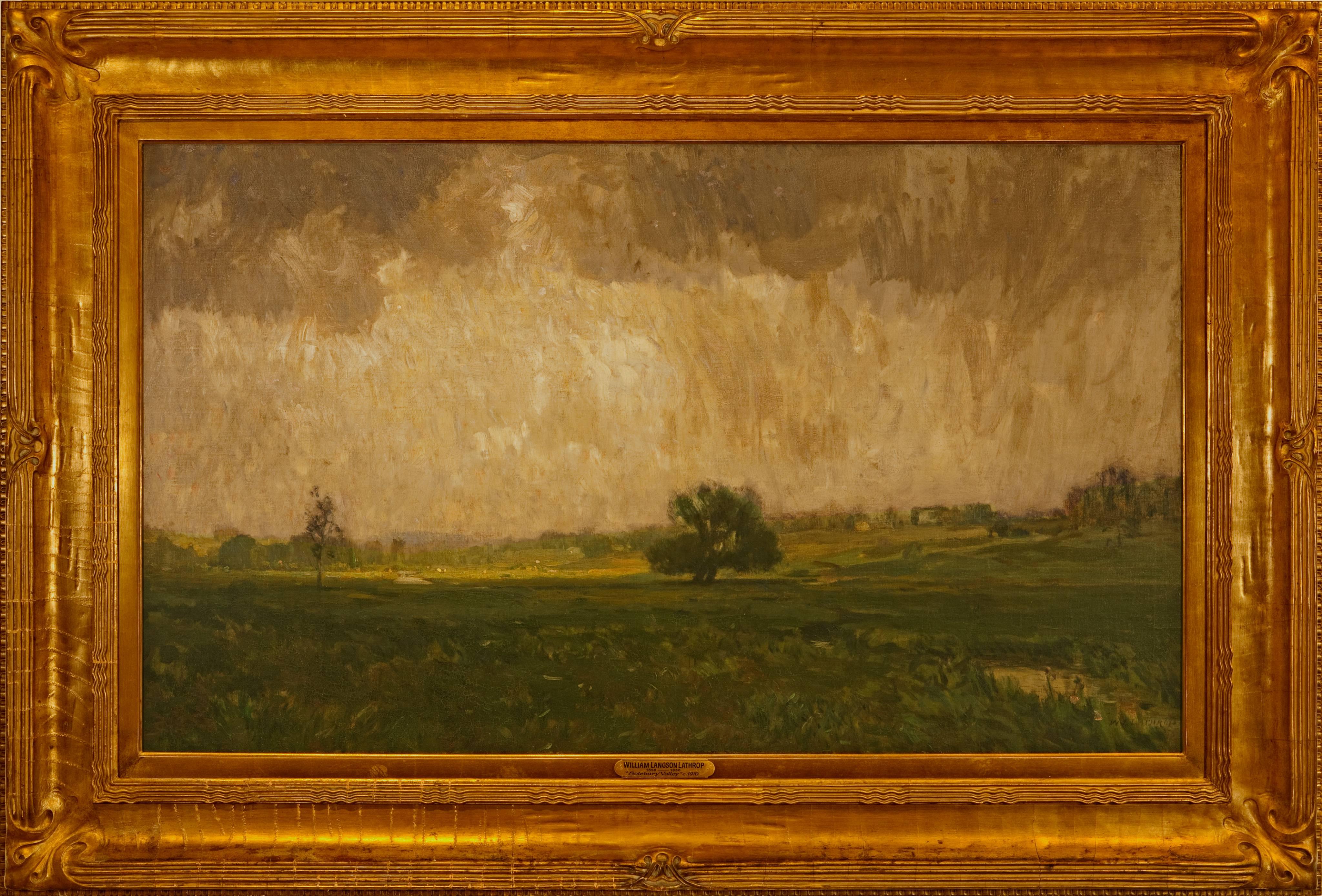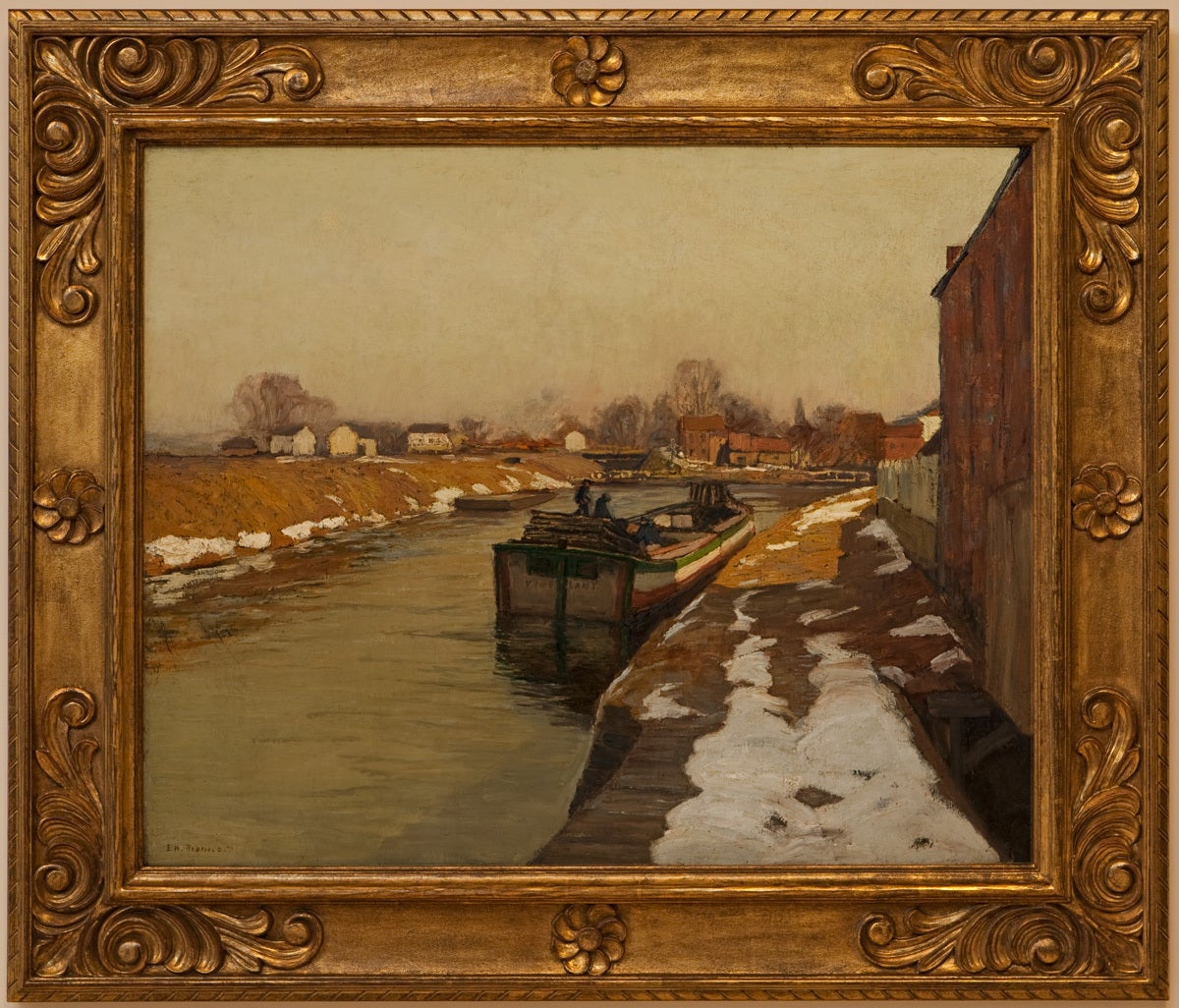Items Similar to Glowing Wave Crashing at the Shore - Seascape
Want more images or videos?
Request additional images or videos from the seller
1 of 19
William Henry BlackmanGlowing Wave Crashing at the Shore - Seascapec. 1970
c. 1970
About the Item
Highly detailed seascape by William Henry Blackman (American, b. 1930). A wave crashes at the shore, glowing from the sun shining through. Above the wave, a few gulls glide across the scene. The rocks in the foreground and the cliffs in the midground are finely textured, adding a lovely sense of realistic detail.
Signed "Wm. Blackman" in the lower right corner.
Artist's stamp on verso, along with other inventory markings.
Artist's name written on edge of canvas.
Presented in an ornate wood frame with a linen liner and fillet.
Canvas size: 18"H x 24"W
William Henry Blackman (American, b. 1930) was born in San Diego, CA in 1930. He spent most of his early years in West Los Angeles. Blackman began painting at age 12. In high school he majored in art so he could experiment with various mediums to find ways to interpret his ideas. In December of 1948 he joined the Navy and was stationed in Hawaii. He studied at Woodbury College where he learned advertising and graphic arts.
In 1960 he bought a home with his wife Shirley in the San Fernando Valley and worked as an advertising manager. His position put him in contact with art directors and they would lunch together and then visit various art galleries in the area. He began oil painting again as a hobby.
In 1964 he made an important contact through an associate at his agency. This person was a vice-president at Aaron Brothers Galleries and purchased paintings for them. They had showrooms in various major cities and sold original framed paintings to art galleries and furniture stores. He said they could possibly sell some of his seascapes so Bill began painting in his spare time. Gradually, they sold more than he could produce so Bill made the decision to leave the advertising business and devote his time to painting. Note: the original Aaron Brothers Art Galleries Certificate included with the painting.
In 1965 the Blackman's moved to Thousand Oaks, California. He began his career as a fine artist and to this day resides in Thousand Oaks. He contracted with Aaron Brothers to be his exclusive agents and began specializing in seascapes. After a few years he added landscapes and some other subjects. Bluebonnet landscapes and Padre Island seascapes were popular in the Dallas showroom.
He was also represented by the Davis Gallery in Honolulu. A good relationship with "Barney" Davis continued after the closing of the Aaron Brothers Wholesale Division in 1980. He painted for the Davis Gallery for about 8 years until they closed due to illness. Afterwards, he was contacted by Kobayashi Art Enterprises and has been represented by them.
In 1980 he began teaching in private studios around the country, demonstrating his method of painting. During the latter part of the 80's he was approached by Susan Scheewe Publishing to author and illustrate a book showing his way of painting. The first was published in 1990 and he has authored four other books since then. He provided demonstrates for six different instructional video tapes that were produced by his artist friend Gary Jenkins.
William Blackman is a published artist. Twenty subjects have been lithographed, six being limited editions, when he was with Aaron Brothers. One of his Hawaiian paintings "Island Mangos" was published by Kobayashi Art Enterprises.
He has been represented by the following art galleries since 1980: Davis Gallery, Honolulu; Simic Gallery, Carmel; Addi Gallery, Reno; Copenhagen Gallery, Solvang, CA; Herbert Arnot, NY; Cosmopolitan Fine Art, La Jolla, CA and Kobayashi Art Enterprises.
- Creator:William Henry Blackman (1930, American)
- Creation Year:c. 1970
- Dimensions:Height: 28 in (71.12 cm)Width: 34 in (86.36 cm)Depth: 2 in (5.08 cm)
- Medium:
- Movement & Style:
- Period:
- Condition:Professionally cleaned and treated with UV-resistant varnish. New hanging hardware included.
- Gallery Location:Soquel, CA
- Reference Number:
About the Seller
4.9
Platinum Seller
These expertly vetted sellers are 1stDibs' most experienced sellers and are rated highest by our customers.
Established in 1986
1stDibs seller since 2014
2,523 sales on 1stDibs
Typical response time: <1 hour
- ShippingRetrieving quote...Ships From: Soquel, CA
- Return PolicyA return for this item may be initiated within 14 days of delivery.
More From This SellerView All
- Mid Century Landscape Autumn TreesBy Rod QuesadaLocated in Soquel, CAVibrant mid century landscape of a pathway through a vivid canopy of autumn trees by Rod Quesada (American, 20th century). Signed "R. Quesad...Category
1970s American Impressionist Landscape Paintings
MaterialsOil, Canvas
- Country Cottage at SunriseLocated in Soquel, CACountry Cottage at Sunrise Cottage in the morning on a winding path by an unknown American artist. Circa 1930-40. Image 18"H x 15"W Frame, 21"H x 17...Category
1930s American Impressionist Landscape Paintings
MaterialsOil, Canvas
- Monterey Coastal Mountains LandscapeBy Jack LynnLocated in Soquel, CAGorgeous plein air landscape painting of green fields with California mountains and the coast in the background by Monterey area artist Jack Lynn (American, 20th Century). Unframed. ...Category
1990s American Impressionist Landscape Paintings
MaterialsOil, Canvas
- Wooded Landscape with Heavy Impasto - Oil on Artist's BoardLocated in Soquel, CAHeavily textured landscape by an unknown artist (20th Century). This piece is executed with heavy, confident brushstrokes, depicting a shaded stream in the woods. Small dabs of paint...Category
1960s American Impressionist Landscape Paintings
MaterialsCanvas, Oil, Illustration Board
- "Pilgrimage" - Mid Century Figurative LandscapeBy Mary MillerLocated in Soquel, CA"Pilgrimage", a mid century figurative landscape by Carmel, California artist Mary Miller (Klepich) (American, ? - 1957). Presented in a rustic giltwood frame. Signed "Mary Miller" lower right. Titled "Pilgrimage," dated "1952" and signed "Mary Miller" on logo on verso, with Santa Cruz Art League Twenty Third Statewide Art Exhibition Label. Image, 18"H x 24"L. Framed size: 22.5"H x 28.5"W. Mary Miller (Klepich) exhibited in the Twenty-Third Annual Santa Cruz State-Wide Art Exhibition. She and her husband Fred Klepich studied at Bellas Artes, San Miguel de Allende in Mexico. Fred and Mary Owned Carmel Craft Studios, later (SAS) Studio Art Supplies...Category
1950s American Impressionist Landscape Paintings
MaterialsCanvas, Oil, Cardboard
- Northern California Golden Valley - Farm Landscape in Oil on CanvasLocated in Soquel, CANorthern California Golden Valley - Farm Landscape in Oil on Canvas Northern California Summer Landscape by Majel McHugh Logan (American, 1916-1982). Signed "Majel Logan" in the lower right corner. Dated on verso. Canvas size: 11"H x 14"W Majel Logan (nee McHugh) (American, 1916-1982) was born in Utah. After graduation from St. Mary of the Wasatch College in Utah, she studied at the Pennsylvania Academy of Fine Arts. She continued to study at Idaho State University before eventually settling in Santa Clara, CA. Although she was a professional artist at the time, she nonetheless continued her studies at San Jose State University in the 1970s. By the mid-70s, she had won 43 awards in state, regional, and local competitions, including Fiesta des Artes (Los Gatos...Category
1980s American Impressionist Landscape Paintings
MaterialsCanvas, Oil
You May Also Like
- At the ClotheslineBy Irving Ramsey WilesLocated in New York, NYSigned lower right: Irving R. WilesCategory
Late 19th Century American Impressionist Landscape Paintings
MaterialsCanvas, Oil
- "Alley Fiends"By John R. GrabachLocated in Lambertville, NJJim’s of Lambertville is proud to offer this artwork by: John R. Grabach (1886 - 1981) John Grabach was a highly regarded New Jersey artist, teacher, and author of the classic text...Category
1930s American Impressionist Landscape Paintings
MaterialsCanvas, Oil
- "Forest Strongholds"By John F. CarlsonLocated in Lambertville, NJSigned lower right. Complemented by a hand carved and gilt frame. Exhibited at the National Academy of Design, 1928Category
20th Century American Impressionist Landscape Paintings
MaterialsCanvas, Oil
- "Solebury Valley"By William Langson LathropLocated in Lambertville, NJSigned lower right. Complemented by a period frame. William L. Lathrop (1859-1938) Deemed “Father of the New Hope Art Colony”, William Langson Lathrop was born in Warren, Illinois. He was largely self-taught, having only studied briefly with William Merritt Chase in 1887, at the Art Students League. Lathrop first moved east in the early 1880s, and took a job at the Photoengraving Company in New York City. While there, he befriended a fellow employee, Henry B. Snell. The two men became lifelong friends and ultimately, both would be considered central figures among the New Hope Art Colony. Lathrop's early years as an artist were ones of continuing struggle. His efforts to break through in the New York art scene seemed futile, so he scraped enough money together to travel to Europe with Henry Snell in1888. There he met and married an English girl, Annie Burt. Upon returning to New York, he tried his hand at etching, making tools from old saw blades...Category
1910s American Impressionist Landscape Paintings
MaterialsCanvas, Oil
- Winter MoonlightBy George William SotterLocated in Lambertville, NJsigned lower rightCategory
1910s American Impressionist Landscape Paintings
MaterialsCanvas, Oil
- "The Canal"By Edward Willis RedfieldLocated in Lambertville, NJJim’s of Lambertville is proud to offer this artwork. Signed lower left. Complemented by a hand carved and gilt frame. Illustrated in "Edward Redfield: Just Values and Fine Seeing" by Constance Kimmerle and the Pennsylvania Academy of the Fine Arts's Exhibition of Paintings by Edward Redfield (April 17 to May 16, 1909) brochure Edward Willis Redfield (1869 - 1965) Edward W. Redfield was born in Bridgeville, Delaware, moving to Philadelphia as a young child. Determined to be an artist from an early age, he studied at the Spring Garden Institute and the Franklin Institute before entering the Pennsylvania Academy from 1887 to 1889, where he studied under Thomas Anshutz, James Kelly, and Thomas Hovenden. Along with his friend and fellow artist, Robert Henri, he traveled abroad in 1889 and studied at the Academie Julian in Paris under William Bouguereau and Tony Robert-Fleury. While in France, Redfield met Elise Deligant, the daughter of an innkeeper, and married in London in 1893. Upon his return to the United States, Redfield and his wife settled in Glenside, Pennsylvania. He remained there until 1898, at which time he moved his family to Center Bridge, a town several miles north of New Hope along the Delaware River. Redfield painted prolifically in the 1890s but it was not until the beginning of the twentieth century that he would develop the bold impressionist style that defined his career. As Redfield’s international reputation spread, many young artists gravitated to New Hope as he was a great inspiration and an iconic role model. Edward Redfield remained in Center Bridge throughout his long life, fathering his six children there. Around 1905 and 1906, Redfield’s style was coming into its own, employing thick vigorous brush strokes tightly woven and layered with a multitude of colors. These large plein-air canvases define the essence of Pennsylvania Impressionism. By 1907, Redfield had perfected his craft and, from this point forward, was creating some of his finest work. Redfield would once again return to France where he painted a small but important body of work between 1907 and 1908. While there, he received an Honorable Mention from the Paris Salon for one of these canvases. In 1910 he was awarded a Gold Medal at the prestigious Buenos Aires Exposition and at the Panama-Pacific Exposition of 1915 in San Francisco, an entire gallery was dedicated for twenty-one of his paintings. Since Redfield painted for Exhibition with the intent to win medals, his best effort often went into his larger paintings. Although he also painted many fine smaller pictures, virtually all of his works were of major award-winning canvas sizes of 38x50 or 50x56 inches. If one were to assign a period of Redfield’s work that was representative of his “best period”, it would have to be from 1907 to 1925. Although he was capable of creating masterpieces though the late 1940s, his style fully matured by 1907 and most work from then through the early twenties was of consistently high quality. In the later 1920s and through the 1930s and 1940s, he was like most other great artists, creating some paintings that were superb examples and others that were of more ordinary quality. Redfield earned an international reputation at a young age, known for accurately recording nature with his canvases and painting virtually all of his work outdoors; Redfield was one of a rare breed. He was regarded as the pioneer of impressionist winter landscape painting in America, having few if any equals. Redfield spent summers in Maine, first at Boothbay Harbor and beginning in the 1920s, on Monhegan Island. There he painted colorful marine and coastal scenes as well as the island’s landscape and fishing shacks. He remained active painting and making Windsor style furniture...Category
Early 1900s American Impressionist Landscape Paintings
MaterialsCanvas, Oil





